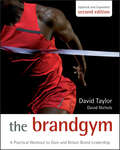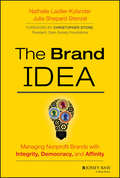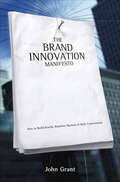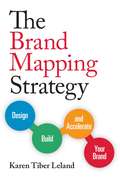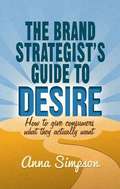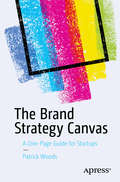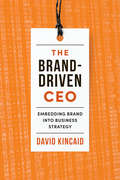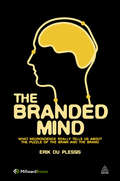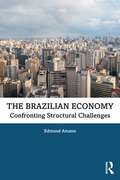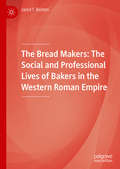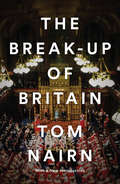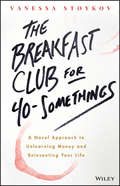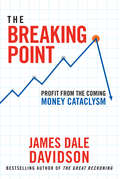- Table View
- List View
The Brand Gym
by David Nichols David TaylorThis refreshingly simple, practical guide demonstrates how brand management can boost business performance. It is the ideal inspiration for creating growth in today's tough economic times. Following the template of the highly successful original version, the book consists of a programme of 8 "workouts" that will help marketers raise their own game in key areas such as: insight, portfolio strategy, positioning and innovation. The tools and techniques in the book have been road-tested on over 100 brandgym projects out of the last 8 years, making this book extremely practical.Based on the inside stories of brand leaders who have achieved success: Tesco, T-Mobile, Unilever and Proctor and Gamble. These companies share their tips, tricks and warn of the traps to avoid.50% of the content is new or updated with the latest thinking on "recession proof branding", how to win when times are tough, communication briefing, growing the core business and new research with marketing directors on the key success factors of brand leaders.The authors are most influential, appearing in The Guardian, Marketing, Brand Strategy, Market Leader and The Marketer. The CIM have called David Taylor one of the "World's 50 most important marketing thinkers".
The Brand IDEA: Managing Nonprofit Brands with Integrity, Democracy, and Affinity
by Nathalie Laidler-Kylander Julia Shepard StenzelOffering a new framework for nonprofit brand management, this book presents the Brand IDEA (Integrity, Democracy, and Affinity). The framework eschews traditional, outdated brand tenets of control and competition largely adopted from the private sector, in favor of a strategic approach centered on the mission and based on a participatory process, shared values, and the development of key partnerships. The results are nonprofit brands that create organizational cohesion and generate trust in order to build capacity and drive social impact. The book explores in detail how nonprofit organizations worldwide are developing and implementing new ways of thinking about and managing their organizational brands.
The Brand Innovation Manifesto: How to Build Brands, Redefine Markets & Defy Conventions
by John GrantThe days of the image brands are over, and new marketing has gone mainstream. The worlds biggest companies are pursuing a post-advertising strategy, moving away from advertising and investing in leading edge alternatives. In the vanguard of the revolution has been John Grant, co-founder of the legendary agency St. Lukes and author of The New Marketing Manifesto, whose radical thinking has informed a generation. Now Grant is set to stun the industry again. In The Brand Innovation Manifesto, he redefines the nature of brands, showing why old models and scales no longer work and revealing that the key to success today is impacting peoples lifestyles (think Starbucks, iPod and eBay). At the heart of the book is the concept of the brand molecule to which new cultural ideas can be constantly added to keep pace with change. Cataloguing 32 classes of idea, Grant presents a practical approach to mixing and matching them within your own market to develop new brand ideas - and new ideas for existing brands.
The Brand Mapping Strategy: Design, Build, and Accelerate Your Brand
by Karen LelandA fundamental paradigm shift has occurred in marketing and branding. Today the most successful CEOs, executives, entrepreneurs and enterprises set their sites on developing a long-term platform instead of a short-term strategy that supports and builds buzz for their personal or business brand. That's really the key to the new business mindset - the recognition that branding and marketing are an ongoing, steady stream of small efforts, not a series of gigantic pushes. Social media, blogging and other business development activities - both online and off - are about the persistent, ongoing process of building a platform, creating credibility and increasing the number of people that you funnel into your potential client and network pipeline.Converting those people into clients or fans may take a month, a year or two years, but the new mindset leads you to strategies that will keep that pipeline full. In short, you need to start a bunch of small fires to keep your brand burning hot. How can today's CEOs, executives and entrepreneurs keep these fires going and powerfully get their messages across, motivate others to action and be authentic - all while simultaneously shepherding initiatives from creation to implementation in high-demand markets?CEO, executive and team branding are key factors that enable effective leaders to achieve peak performance, gain greater influence in their industries and generate increased engagement within their companies. By creating a brand (business or personal) by design instead of default, leaders and companies bring their brand promise into every interaction across the board.A personal, team or business brand is not just a single statement or a clever quip but a multilayered, congruent narrative told across multiple channels - online and off - within the organization and to the business community at large. The power is in knowing how to tell the story.The book will introduce CEOs and executives in Fortune 500 companies and entrepreneurs in SMBs to the SMG Brand Mapping Process©, a process that willguide them in creating personal, team and business brands that work in harmony and parallel with each other.
The Brand Strategist’s Guide to Desire
by Anna SimpsonBlending emotional branding and sustainable thinking, this book will help brands understand the foundations of desire to create sustainable brand loyalty, healthier societies, and more fulfilled customers. Supported by interviews and case studies, Simpson explores five primary desires: self-worth, social life, culture, comfort, and exploration.
The Brand Strategy Canvas: A One-Page Guide for Startups
by Patrick WoodsLaunching a startup is now easier than ever before. Building a lasting brand, however, remains a mystery for even the savviest of founders. An impactful, recognizable brand is perhaps a company’s most valuable intellectual property. And any strong brand starts with a strategy.The Brand Strategy Canvas has arrived to coach you beyond buzzword-laden tips and tricks, and instead offers you thorough, practical techniques to jump-start your strategy creation process. Author Patrick Woods distills fundamental questions to guide your strategy into a revolutionary single-page tool known as the titular Brand Strategy Canvas. The book takes you through each of the simple yet thought-provoking questions of the tool to develop your strategy, including considering audience insight, assessing benefits, creating a positioning statement, and identifying key messages. You will explore real-world case studies along the way and build a message map that ensures your organization drives home a consistent, clear, and authentic message to your target audience. No matter where you are in the business creation process, The Brand Strategy Canvas is the tool you need to build a brand from scratch that you can enthusiastically and effectively implement in real time. This book provides value to team members in companies of all sizes and stages, and is fit for any level of professional wanting to kickstart their entrepreneurial goals. A brand created today must be built for all of tomorrow’s possibilities, and The Brand Strategy Canvas is the book you will want by your side. What You Will LearnExamine the key differences between strategy and executionUnderstand how you can avoid brand debtCraft meaningful messages with the Features>Benefits ContinuumDevelop a positioning statement that differentiates from the competition and inspires your marketingDiscover your distinctive brand personality and how it impacts your marketing Equip your team with guidance and inspiration to ensure consistent and inspiring voice and personality throughout all your messaging Who This Book Is For This book is for startup founders who are looking for tools to help them build a brand their team can actually implement. This book will also resonate with and provide value to team members in tech companies of all sizes and stages.
The Brand Who Cried Wolf
by Scott DemingBranding has become the narrow responsibility of the marketing department, and customers have stopped believing the ads. This book shows you how to build a powerful, lasting brand. You will learn how to involve the entire organization, from sales, customer service, shipping, product design, and marketing, in the branding process. The author discusses how to create powerful, emotional, and unique experiences for others, turn every customer into an evangelist, and greatly expand your reach of influence. Use this book to define your personal and professional brand.
The Brand You 50: Fifty Ways to Transform Yourself from an 'Employee' into a Brand That Shouts Distinction, Commitment, and Passion! (Reinventing Work Series)
by Tom PetersA small (5. 25x7) but spunky book packed with tools for meeting the challenges of the business revolution. Lists and tips exhort readers to think of themselves as freelance contractors, even when employed by a company, and give advice on designing a business card, landing jobs, networking, crafting an image, and building skills. Lacks a subject index. Annotation c. Book News, Inc. , Portland, OR (booknews. com)
The Brand-Driven CEO: Embedding Brand into Business Strategy
by David KincaidThe Brand-Driven CEO demonstrates how senior leadership can use their brand to align and guide the behaviours, decisions, and operations of their entire organization and drive brand and shareholder value. Author David Kincaid delivers practical assessments and game plans for senior executives and managers across functional areas, clarifying the confusion between brand and marketing management. He introduces the "New 4P’s" of brand management: people, process, IP, and partnerships. This paradigm shift equips business leaders with a new approach to managing growth, profitability, risk, and sustainable value creation. Using real life, current case studies from today’s fastest growing and most valuable brands – including Starbucks, Apple, and BMW – this book reveals how big businesses are being led and managed as integrated business systems and not by marketing departments. The Brand-Driven CEO includes criteria to conduct your own brand self-assessment and a step-by-step roadmap that can be applied to help transform your brand and its management.
The Branded Mind: What Neuroscience Really Tells Us About the Puzzle of the Brain and the Brand
by Erik Du PlessisThe Branded Mind is about how people think, and particularly how people think about brands. It explores what we know about the structure of the brain, how the different parts of the brain interact, and then demonstrates how this relates to current marketing theories on consumer behaviour. Investigating developments in neuroscience and neuromarketing, and how brain science can contribute to marketing and brand building strategies, The Branded Mind is based on exclusive research by Millward Brown, one of the World's top market research companies. This unique and insightful book covers everything from the nature of feelings, emotions and moods, to consumer behaviour, decision making and market segmentation, and how to use these insights to the benefit of your brand.
The Brass Check: A Study of American Journalism (American Journalists Ser.)
by Upton SinclairA muckraking exposé of corruption in American journalism from the Pulitzer Prize-winning author of The Jungle Upton Sinclair dedicated his life to documenting the destructive force of unbridled capitalism. In this influential study, he takes on the effect of money and power on mass media, arguing that the newspapers, magazines, and wire services of the Progressive era formed "a class institution serving the rich and spurning the poor." In the early twentieth century, a "brass check" was a token purchased by brothel patrons. By drawing a comparison between journalists and prostitutes, Sinclair highlights the total control publishers such as William Randolph Hearst exerted over their empires. Reporters and editors were paid to service the financial and political interests of their bosses, even if that meant misrepresenting the facts or outright lying. Sinclair documents specific cases, including the Ludlow Massacre of 1914 and the Red Scare whipped up by Hearst's New York Journal and other newspapers, in which major news outlets ignored the truth in favor of tabloid sensationalism. Sinclair considered The Brass Check to be his most important and most dangerous book. Nearly a century later, his impassioned call for reform is timelier than ever. This ebook has been authorized by the estate of Upton Sinclair.
The Brave New World of eHR
by Eduardo Salas Dianna L. Stone Hal GueutalThe Brave New World of eHR is an important resource, filled with the most current information and practical advice on eHR for human resource professionals and industrial and organizational psychologists. Written by an expert group of scholars, practitioners, and subject matter experts, this book offers an overview of the major technological trends in eHR, and shows how to use technology to enhance organizational effectiveness. Comprehensive in scope, the book includes information on a wide variety of topics and Reviews the transformation of human resources from manual processes to sophisticated CRM and ERP systems Examines the effectiveness of online strategies for attracting talent Offers valuable guidelines that can help organizations design, deliver, implement, and sustain e-selection systems Includes a review of the recent research on the effectiveness of distance learning in educational and organizational settings Analyzes the potential advantages and disadvantages of using eHR to manage employee performance Shows how technology supports the administration of compensation systems Outlines recent trends in delivering HR products and services Considers the functional and dysfunctional consequences of using eHR to attract, select, and manage the performance of employees in organizations Presents a fascinating and futuristic look at HR and technology for decades to come
The Bravest You: Five Steps to Fight Your Biggest Fears, Find Your Passion, and Unlock Your Extraordinary Life
by Adam Kirk SmithA Breakthrough Bravery System to Confront Your Greatest Fears, Find Your Purpose, and Create the Successful Life You Want Feeling directionless, or perhaps too intimidated to make a necessary change in your life? Tired of letting your fears keep you from achieving your goals or becoming healthier, happier, or more successful? If so, this book is for you. Popular life coach and consultant Adam Smith has created a powerful method to help you harness your inner passion and drive to overcome whatever is holding you back. The Bravest You presents the five-step Bravery Process™, an easy and highly effective way to master our biggest fears. Offering inspiring and helpful advice, Smith guides you through each of stage of the process—Complacency, Inspiration, Fear, Passion, Bravery—showing how to identify goals and passions and apply the Bravery Process to any circumstance. These proven techniques will empower you to conquer your doubts once and for all and become your bravest self. Covering the ten most common fears all successful people face, from the fears of inadequacy and being judged, to rejection, failure, loss of control, and loneliness, The Bravest You arms you with the necessary tools to tackle any fear-inducing situation head-on and lead the braver, happier, and more successful life you’ve always imagined.
The Brazilian Economy Today: Towards A New Socio-economic Model?
by Lauro Mattei Anthony PereiraPereira and Mattei bring contributors together in this exciting volume to further understanding about the recent Brazilian Economic Development Model and discuss the related social conditions. The authors analyze both the political economy and social public policies to highlight new opportunities to create a sustainable development model.
The Brazilian Economy: Confronting Structural Challenges
by Edmund AmannThe Brazilian economy has long been defined by its enormous potential. Over the past 30 years, some of this has at last been realised. Latin America’s largest economy has rapidly risen in global importance while poverty at home has declined. Yet, despite periods of progress, Brazil remains prone to economic crisis. It is also beset with stubborn inefficiencies and income disparities. This book considers the structural challenges which will need to be overcome if Brazil is to break with the past and finally embark on a path of sustained, inclusive growth. This book aims to give the reader a clear knowledge of the nature of these structural challenges, why they exist and the effectiveness of attempts to overcome them. Through this, readers will gain a deep understanding of the contemporary Brazilian economy. The challenges discussed fall into three areas: those centring on competitiveness and the supply side, those arising from critical macroeconomic issues and those connected with environmental sustainability and social inclusion. This volume systematically examines each of these domains, highlighting such vital topics as export competitiveness, human capital formation, environmental policy and the role of financial market reform. Where appropriate, this book sets Brazil’s experience in an international comparative context. It points out that many of the challenges faced by Brazil are shared by other emerging economies. In this sense, the policy lessons which stem from this volume have broader international relevance. This book will be vital reading for all those seeking in-depth understanding of one of the world’s most important, yet troubled, economies. This readership is likely to include undergraduate and postgraduate students on development economics and Latin American area studies programmes, policymakers wanting an up-to-date and coherent analysis of Latin America’s largest economy, and financial professionals.
The Brazilian Empire: Myths and Histories
by Emilia Viotti Da CostaThe book explores the social, political, economic, and intellectual currents that shaped nineteenth-century Brazil and whose reverberations continue to be felt throughout contemporary Brazilian society.
The Bread Makers: The Social and Professional Lives of Bakers in the Western Roman Empire
by Jared T. BentonBread was the staple of the ancient Mediterranean diet. It was present in the meals of emperors and on the tables of the poorest households. In many instances, a loaf of bread probably constituted an entire meal. As such, bread was both something that unified society and a milieu through which social and ethnic divisions played out. Similarly, bakers were not a monolithic demographic. They served both the rich and the poor, but some bakers clearly operated within regional traditions. Some lived in big cities and others lived in small towns. Some bakers made flat breads and others made leavened loaves. Some made coarse brown loaves and others specialized in fancier white breads. This book offers new methods and new ways of framing bread production in the Roman world to reveal the nuances of an industry that fed an empire. Inscriptions, Roman law, and material remains of Roman-period bakeries are combined to expose the cultural context of bread making, the economic context of commercial baking, the social hierarchy within the workforces of bakeries, and the socio-economic strategies of Roman bakers.
The Break-Up of Britain
by Tom NairnThe classic text, with a new introduction by Anthony Barnett In this classic text, first published in 1977, Tom Nairn memorably depicts the &“slow foundering&” of the United Kingdom on the rocks of constitutional anachronism, its fall from empire and the gathering force of civic nationalism. Rich in comparisons between the nationalisms of the British Isles and those of the wider world, The Break-Up of Britain concludes by reflecting on the Janus-faced nature of national identity. Postscripts from the Thatcher and New Labour years trace the political strategies whose upshot accelerated the demise of a British order they were intended to serve. As a second Scottish independence referendum beckons, a new introduction by openDemocracy&’s Anthony Barnett underlines the book&’s enduring relevance.
The Breakdown of Capitalism: A History of the Idea in Western Marxism, 1883-1983 (Routledge Library Editions: The History of Economic Thought)
by F. R. HansenThis comprehensive and lucid study, first published in 1985, reconstructs the history of Western Marxist theories of the breakdown of capitalism. It provides a critical reading of theories of breakdown, with their conflicting interpretations of a single text, their invulnerability to empirical defeat, and their retreat from class analysis, as events in the history of ideas. This study traces the sources of theoretical conflict in a series of historical and epistemological issues that shift over time and generate new conditions for speculations concerning the fate of the system. In seeking to understand that durability of the concept of breakdown, the author raises important questions about the social conditions and consequences of theoretical work and the status of critical thought in society. This title will be of interest to students of history and economics.
The Breakdown of Hierarchy
by Eugene Marlow Patricia O' Connor Wilson Helen MarlowThe Breakdown of Hierarchy explores the changes that have taken place in the second half of the 20th century and how organizations of all sizes can harness electronic media to open the lines of dialogue and corporate conversation. Never before published case studies of Honeywell, Motorola and Raychem are discussed. Eugene Marlow has been involved with the strategic application of print and electronic media for over 25 years. He has consulted to dozens of organizations in the media, technology, healthcare, consumer products, and non-profit sectors. Dr. Marlow teaches graduate and undergraduate courses in electronic journalism and business communications at Bernard M. Baruch College (City University of New York).Patricia O'Connor Wilson works for the Center for Creative Leadership (CCL), an international non-profit educational institution devoted to behavioral science research, executive development, and leadership education. Based in Greensboro, North Carolina, the Center also has educational facilities and network associates throughout the world. Ms. Wilson has also conducted research in the areas of managerial effectiveness, self-efficacy and entrepreneurialism.
The Breakfast Club for 40-Somethings: A Novel Approach to Unlearning Money and Reinventing Your Life
by Vanessa StoykovHigh school's over. We're no longer the nerd, the athlete, the princess or the bad boy. Instead, we are the parent, worker, wife, husband, daughter or son. But we all have things in common - and one of them is money. <p><p> People have always sought financial freedom, but our influences, from our parents to our community, have made our grounding in money anything but helpful. In fact, that grounding might be the thing that is holding us back. The Breakfast Club for 40-Somethings draws upon the five major lessons you need to unlearn about the way you see your life and money to give you the best chance of getting the future you want. <p> Written in the form of a novel from the perspective of six unique characters, the book explores how the different financial decisions and behaviours of each character have led to their current situations. Through this entertaining story, this guide presents the invaluable financial and life lessons you need to understand, to build a solid foundation for your life, no matter your situation. <p> If you don't like traditional self-help or finance books, this is for you. The Breakfast Club for 40-Somethings offers a new and entertaining way to change your long-term financial behaviours for the better.
The Breaking Point: Profit from the Coming Money Cataclysm
by James Dale Davidson Bill Bonner"Picketty (the rich get richer), Gordon (the important innovations are already behind us), Tainter (it's too complicated) all have theories about why the 21st century is such a disappointment. James Dale Davidson connects the dots...but more dots...and more unexpected dots...than perhaps anyone."-From the Foreword by BILL BONNER, coauthor of International bestseller The Empire DebtIS YOUR PORTFOLIO POSITIONED FOR THE GLOBAL FINANCIAL REVOLUTION?The global economy as we know it is due for a major correction, and with this will come permanent, systemic change: the greatest economic freedom the world has ever seen.But hard financial times are ahead, and The Breaking Point will help you protect your wealth and prosper through it all.Providing a painfully clear view of the state of the global economy, outspoken economist James Dale Davidson uses the old-fashioned tool of argument-facts-to describe how governments have mismanaged the financial system to the point of no return. It has all led to Brexit-the opening salvo in the war for financial freedom.The Breaking Point shows you where we've been and where we're headed, offering the insight and information you need to ensure you're positioned for the worst of times-and the best of times.
The Breakthrough Challenge
by Jochen Zeitz John Elkington Sir Richard BransonThe world's most forward-looking CEOs recognize the real challenge facing business today: a fundamental shift in the nature of commerce. While sustainability programs, government action, and nonprofits are all parts of the solution, CEOs and other leaders must focus on social, environmental, and economic benefit--not only because it will make the world a better place, but because it will ensure lasting profitability and success in the business climate of tomorrow. The Breakthrough Challenge is both an inspiring call-to-action and a guide for this transformation, based on the work of The B Team, a major initiative uniting leaders in sustainability. As a founding advisor and member of The B Team, John Elkington and Jochen Zeitz map out an agenda for change. The most important goal for businesses must be redefining the bottom line to account for true long-term costs throughout the supply chain. To achieve this, leaders must rethink everything: what counts on balance sheets, how to incentivize performance, who does what in the C-suite, and even what inspires us. The Breakthrough Challenge draws on over 100 exclusive interviews to show this shift in action, sharing the pioneering work of leaders such as Paul Polman, CEO of Unilever; Arianna Huffington, founder and CEO of The Huffington Post; Peter Brabeck-Letmathe, chairman of the Nestlé Group; and Linda Fisher, pioneering Chief Sustainability Officer at DuPont, among many others. Change-as-usual strategies are not enough to move business from breakdowns to breakthroughs. The Breakthrough Challenge shows leaders how to achieve a true transformation and refocus the definition of profitability on the lasting wellbeing of people and planet--for the lasting success of their business.
The Breakthrough Company: How Everyday Companies Become Extraordinary Performers
by Keith R. McfarlandBased on a five-year, 7,000-company study The vast majority of small businesses stay small–and not by choice. Only the most savvy and persistent–a tiny one tenth of one percent–break through to the very highest ranks. In The Breakthrough Company, technology CEO and Fortune 500 consultant Keith McFarland draws upon an extensive empirical study to reveal exactly how everyday companies become extraordinary, showing that breakthrough success is associated with a clearly identifiable set of strategies and skills that anyone in any business can emulate–from small startup to industry leader. With powerful and specific action steps concluding each chapter–and invaluable advice on virtually every page from business leaders who’ve taken their companies to extraordinary levels of growth and profitability–The Breakthrough Company is stuffed with real-world tools and myth-busting insights that can be used by anyone wanting his or her business to join this exclusive circle. “Think Good to Great for those still small enough to think big.” —Bob Eckert, chairman and CEO, Mattel, Inc. “If you’re looking for a breakthrough, break open this book.” —Harvey Mackay, author of the #1 New York Times bestseller Swim with the Sharks Without Being Eaten Alive
